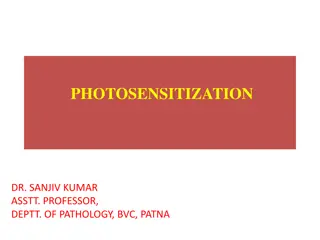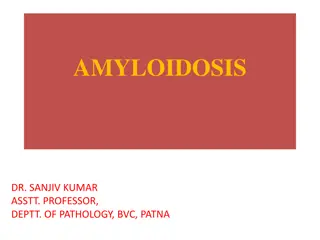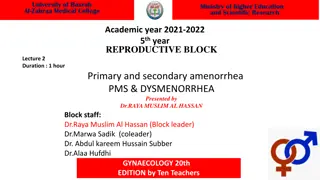Understanding Amenorrhea: Definition, Types, Causes, and Management
Amenorrhea, the absence of menstruation, is classified into primary and secondary types. Primary amenorrhea refers to the failure of menarche to occur by a certain age, while secondary amenorrhea is the absence of menstruation in women of reproductive age for three or more months. The condition can be further categorized into physiological and pathological causes, with various underlying factors such as hypothalamic, pituitary, ovarian, uterine, and vaginal disorders. Understanding the pathophysiology and differentiating between false and true amenorrhea are crucial for proper diagnosis and management to address potential complications and psychological impacts on affected individuals.
Download Presentation

Please find below an Image/Link to download the presentation.
The content on the website is provided AS IS for your information and personal use only. It may not be sold, licensed, or shared on other websites without obtaining consent from the author. Download presentation by click this link. If you encounter any issues during the download, it is possible that the publisher has removed the file from their server.
E N D
Presentation Transcript
AMENORRHEA P R O F E S S O R M U H S I N U N I V E R S T Y B A S R A H A L - S A B B A K O F B A S R A H M E D I C A L S C H O O L
AMENORRHEA: - IT IS A LATIN WORDS MEANS ABSENCE OF MESTREUATION A MEANS NO MENO MEANS MONTH .RRHEA MEANS CYCLE SO THAT MEAN ABSENCE OF MONTHLY CYCLE Objectives Student should be able:- 1-To know definition, types and how to differentiate them 2-To know the predisposing factors for both types of amenorrhea and how to investigates for them 3-To know how to manage these cases and their possible complications 4-To know the psychological impact of amenorrhea on affected patients.
AMENORRHEA SUB DIVIDED INTO DIFFERENT CLASIFICATION:- A- Primary amenorrhea: - Failure of menarche to occur when expected in relation to the onset of pubertal development. Breast bud, pubic hair, axillary hair and menarche. No menarche by age 16 years with signs of pubertal development No onset of pubertal development by age 14 years B-Secondary amenorrhea Absence of menstruation for 3 or more months in a previously menstruating women of reproductive age. It is also divided into physiological and pathological A-Physiological amenorrhea occurred in pre-pubertal age, pregnancy, lactation and menopause. B-Pathological amenorrhea
-Pathological amenorrhea caused by different hypothalamic, pituitary, ovarian, uterine and vaginal disorder and pathologies which was needed to be completely healthy in order to have normal menstruation plus endocrine disorder. Some authors sub divided amenorrhea into false and true amenorrhea. Those with false amenorrhea they had normal cycles but it is hidden somewhere also called crypto menorrhea means (hidden cycles) like in imperforate hymen and cervica and vaginal septum and stenosis.
PATHO-PHYSIOLOGY:- A women to have normal menstrual cycle she need to have normal hypothalamico-hypophysial- ovarian- uterine& vaginal axis Any defect in the above chain might result in amenorrhea Gonado-trophin releasing factors released from the hypothalamus which stimulate the pituitary gland to secrete Gonado-trophins FSH & LH which in turn affect the ovaries to secrete estrogen and progesterone &those two hormones will initiate the menstrual cycle.
Hypo-thalamic causes It is sub divided into functional disorder like stressful condition, pseudocyesis, bereavement reaction, loss of relatives and friend, change jobs, fear and even some acute illnesses. Psedocyesis It is defined as strong desire to conceive seen among those with long H/O infertility, so they simulate all symptoms and signs of pregnancy. Their abdomen will show gaseous distension, amenorrhea, nausea and vomiting and they never got satisfied that they are not pregnant even if you do for them ultra- sonography. Organic disorders Destruction, infection, tumor (cranio-pharyngioma) all lead to amenorrhea.
OTHER CAUSES OF AMENORRHEA Pituitary disorders like destruction of the pituitary gland by ischemia which was seen in patient with Sheehan's syndrome , tumor, infection (hypophysitis) and T.B hypophysitis. Sheehan's syndrome which is seen among those with sever P.P.H which will lead to destruction of the anterior pituitary gland either complete destruction with involvement of whole function of the anterior pituitary gland (Gonadotrophic, somatotrophic, thyrotrophic and adreno-cortico trophic which need HRT (hormone replacement therapy) or part of the pituitary gland only the prolactin secreting cells of the pituitary gland which will lead to failure of lactation and breast atrophy. This usually depend on amount of blood loss which will to ischemic changes in the pituitary gland.
Sheehan's syndrome seen among (4% of patients with mild, 8-20% in moderate and about 50% among sever cases of PPH) Anterior pituitary gland affected more because it does normally enlarged in normal pregnancy and blood shifted more to the posterior pituitary lobe during labor which is needed for syntocinon release, so any deprivation of the pituitary gland will simply lead to Ischemia and hence will affect the production of gonadotropins hormones that will lead to amenorrhea. This was treated simply by hormones replacement therapy. That mean supplemental therapy of deficit hormones.
Ovarian causes:- A-Chromosomally competent ovarian failure It seen among women who had normal 46XX genotype Like ovarian Agenesis and dysgenesis and in cases with premature ovarian failure at 25-35 years of age. B- Chromosomally incompetent ovarian failure seen in Turner syndrome 45XO in which there is atretic small size ovaries.
Uterine causes Absence of uterus seen in patient with Mullarian agenesis ( Mayer- Rocky- Tansky Syndrome). Testicular feminization syndrome in which the genotype is 46XY usually here the phenotype is female pattern but she is genotypic ally male. Obliteration of uterine cavity due to frequent and sever D&C resulting in adhesion of uterine cavity and hence lead to amenorrhea called Asher man's syndrome. This was simply diagnosed by absence of with drawl bleeding after the use of contraceptive pills and confirmed by the use of hysteroscopy. This was treated simply by:- Use of contraceptive device after simple D&C and you keep her on estrogen dominant pills to prevent further adhesion. Hysteroscopic resection plus proper hemostasis - B- C-
Endocrine Like thyroid problem usually hypothyroidism rather than hyper because the former lead to hyper- prolactinoma and hence will leads to amenorrhea -Pancreas uncontrolled and childhood diabetes is a cause of amenorrhea -Adrenal cortex:- Adrenogenital syndrome due to tumor of adrenal gland or hypoplasia all leads to amenorrhea -General constitutional upset and diseases like acute illness, chronic debilitating diseases like T.B. mal-absorption syndrome that leads to anorexia nervosa and overweight.
Environmental factors like change in climate,occupation and bereavement reaction to a loss of friends and relatives and so on . -Jogger amenorrhea:- This type of amenorrhea specifically occurred among athletes and ballet dancer and those with heavy exercises and male type of exercises because of androgen over production. Arrhenoblastomas:- This is a type of androgen secreting tumor of the ovary it is also called androblastoma. -Continuous production of androgen and progesterone in certain cases of theca and luteal cyst can lead to amenorrhea ,like pregnancy. PCOS. (poly cystic ovary syndrome).
Puberty amenorrhea: - here there is absence of menstruation after menarche which usually lasted for 8-12 months, it is so common so it considered normal. Drugs Certain drugs might lead to amenorrhea like those that lead to hyper-prolactinemia e.g methyl dopa, cimetidine (H2 receptor blocker), tricyclic antidepressant, metaclopromide, amphetamines, narcotics, reserpine& phenothiazine. Others like contraceptive pills, medroxy progesterone acetate (depo-provera) and cyto-toxics. Irradiation:- Irradiation to the pelvis can lead to amenorrhea in affecting both ovaries to suppress its function and hence lead to amenorrhea.
PROLACTINOMA:-Prolactin is a polypeptide with 128 amino acid, it is related to stress specifically increased in stressful conditions. It shows typical circadian rhythm with increment at early morning and decreased at evening. CAUSES:- 1-physiological includes pregnancy, nursing, exercise, nipple stimulation, sleep and physical and psychological stress. 2-pharmacological drugs like metaclopromide, chloropromazine, promazine, verapamil, methyl dopa, estrogen, reserpine amphetamines and narcotics like pathidine and codeine and so on 3-Idiopathic 4- tumor like prolactinomas where the level of prolactin correlate directly with the size of the tumor of the pituitary gland. 5-others like primary hypothyroidism as 3-5% of those
PROLACTINOMA It is a tumor of the prolactin secreting cell of the anterior lobe of the pituitary gland. Its clinical presentation depend on the size and site of tumor and whether it compress the surrounding tissues that in turn leads to focal neurological signs and visual disturbances. CLINICAL PRESENTATIONS:- -Hypogonadism and amenorrhea in about 94% of cases. -Galactorrhea (non- puerperal secretion of breast milk) in about 85% of cases lead to oligomenorrhea and infertility DIAGNOSIS:- -History suggestive. -Clinical examination looking for nipple discharge, visual field disturbances and so on
LAB INVESTIGATIONS:- -Pregnancy test, TSH and free T4& Creatinine level. -MRI especially for those with raised level of prolactin of more than 100ng/ml and those who don t respond to medical treatments. - Visual field examination. TREATMENT:- -If she took any drug she should stop taking it. -Reassurance for those who had stressful conditions. -Dopamine agonist like Bromocryptine (Parlodel) given in a dose of 2.5micro-gram thrice daily. Starting with once at night taken with the meal because of its miserable side effect which includes nausea, vomiting, postural hypotension, dizziness and drowsiness, abdominal pain, fatigue and even leg cramps, it might be given as vaginal pessaries.
Cabergoline had better effect on reducing prolactin level and less side effects but more expensive. Given in a dose of about 1mg weekly every 3days 0.5mg because its half-life is a 65 hrs. Simple hyper prolactinoma and tumor of less than 10mm in size that called micro adenoma almost had the same treatment by bromocryptine. But macro adenomas of greater than 1cm size or those produce symptoms should be treated by trans- sphenoidal laser resection or ablation. and by radiotherapy in resistant cases or those who fail the surgery.
AMENORRHEA DUE TO OBSTRUCTION TO THE OUTFLOW:- UPPER GENITAL TRACT OBSTRUCTION At the level of cervix and upper vagina (Mullarian duct anomalies) These types of obstruction lead to crypto menorrhea which is not easily treated because can't be managed vaginally, usually it leads to haematometra.
LOWER GENITAL TRACT OBSTRUCTION At the level of lower vagina and vulva like vaginal septum and imperforate vagina respectively. If remain undiagnosed it lead to haematometra and hematocolpus. Need to be drained vaginally after we took consent of the family we did cruciate incision to the hymen and drain all the collected hidden cycle. The above patient usually presented with monthly cyclical abdominal pain and delayed menarche with normal secondary sex character. O/E we saw typically bulging hymen with bluish discoloration. In neglected cases patient might present with retention of urine.
EXAMINATION OF PATIENT WITH AMENORRHEA Look for secondary sex character if present then the primary amenorrhea could be due to:- 1- Constitutional delay puberty need only reassurance. 2- Crypto menorrhea (hidden cycle) due to obstruction to the out flow. 3- Androgen insensitivity that mean there is no response to androgen release. 4- Testicular feminization syndrome If secondary sex character absent then mostly due to:- 1- Genetic abnormality. 2- Ovarian agenesis and dysgenesis.
INVESTIGATIONS:- NEVER TREAT ANY CASE OF AMENORRHEA BEFORE YOU INVESTIGATE FOR ITS CAUSE, 1-Pregnancy test blood and urine test to check for pregnancy especially among those who are presented at their reproductive age. 2-Radiological examination for the pituitary fossa like skull x-ray which may shows either destructed clinoid process in large pituitary tumor or double floor in small microadenomas. 3-Ophthalmic examination by fundoscopy to look for retina and visual disturbances. 4- Urine analysis to check for glycosuria. 5- Hormonal assay.
-Raised FSH / LH indicate the possibility of premature ovarian failure or early menopause. - Raised LH/FSH ratio indicate the possibility of PCOS. -Decrease both FSH and LH ,check other hormones like adrenal and thyroid hormones, if all decrease this patient may had hypopituitarism. If only FSH and LH are low this is called isolated gonadotropin deficiency which is very rare condition. -If prolactin is raised check TSH because hypothyroidism is a cause of hyper-prolactinemia. 6- Genetic study for those with absent secondary sex character or those with ambiguous external genitalia.
7- Laparoscopy to check for streak or absent gonads or absent upper genital tract. 8- Therapeutic test give 0.05 of Ethinyl- estradiol for 21 days with 7 days interval break if she had break through bleeding, this will exclude different types of anomalies especially obstruction, agenesis and adhesions. -Failure to have with drawl bleeding may be caused by pregnancy, psychogenic amenorrhea or androgenic tumor. -Failure of the ovary to raise estrogen after gonadotropin injections during the proliferative phase of the cycle suggests primary ovarian failure. -Failure of the pituitary to increase the gonadotropin secretion after clomiphene citrate treatment indicates pituitary failure
TREATMENT IT SHOULD BE DIRECTED TO THE CAUSE -Reassurance of the patient is always comes first after exclusion of organic causes. -General measures like correction of anemia and proper dieting for those with anorexia nervosa or advices to reduce wt among those who are over wt. -Psychological consultation and therapy is mandatory in certain cases. Any questions? THANKS FOR YOUR NICE THANKS FOR YOUR NICE TTENTION TTENTION























